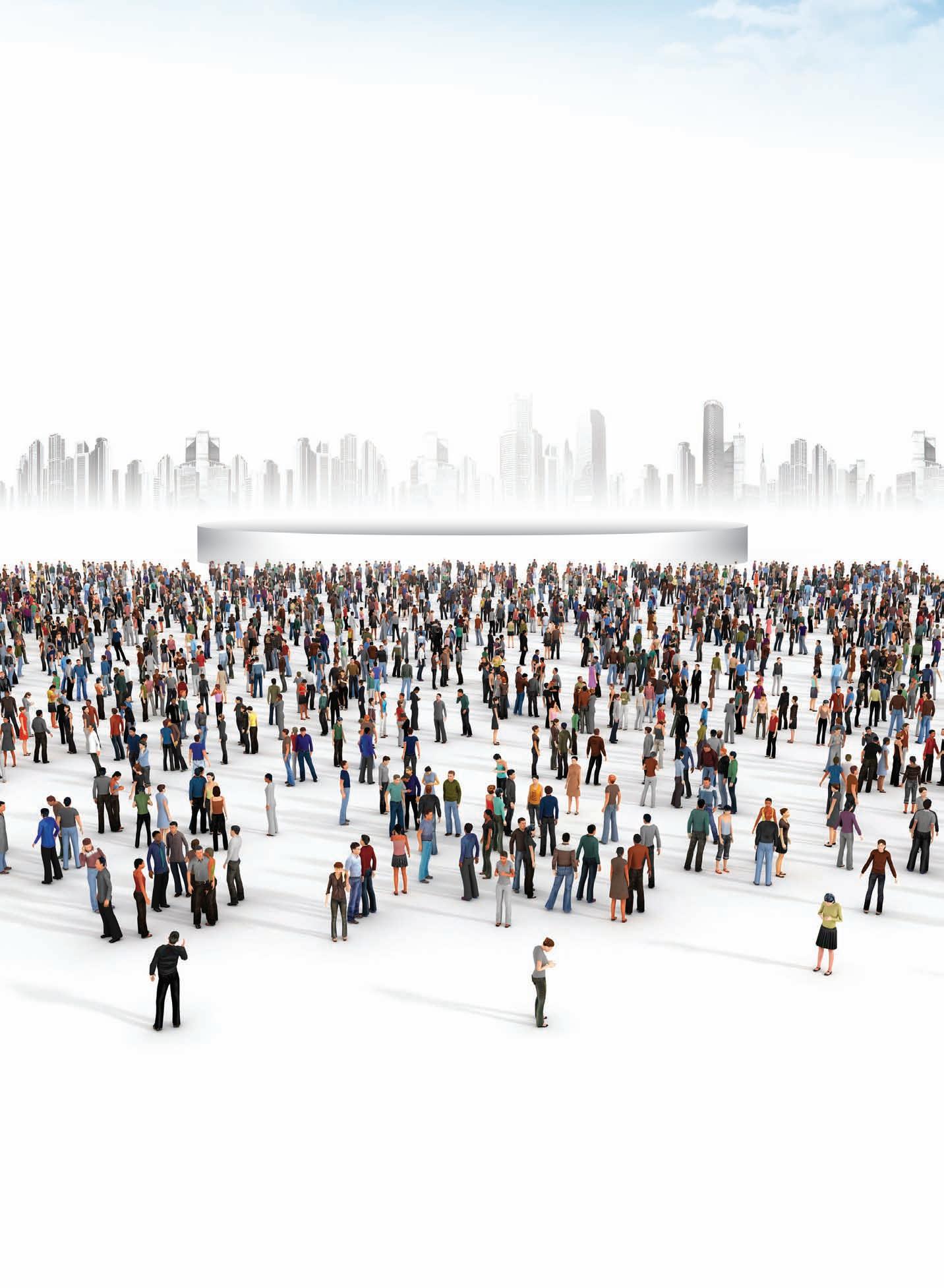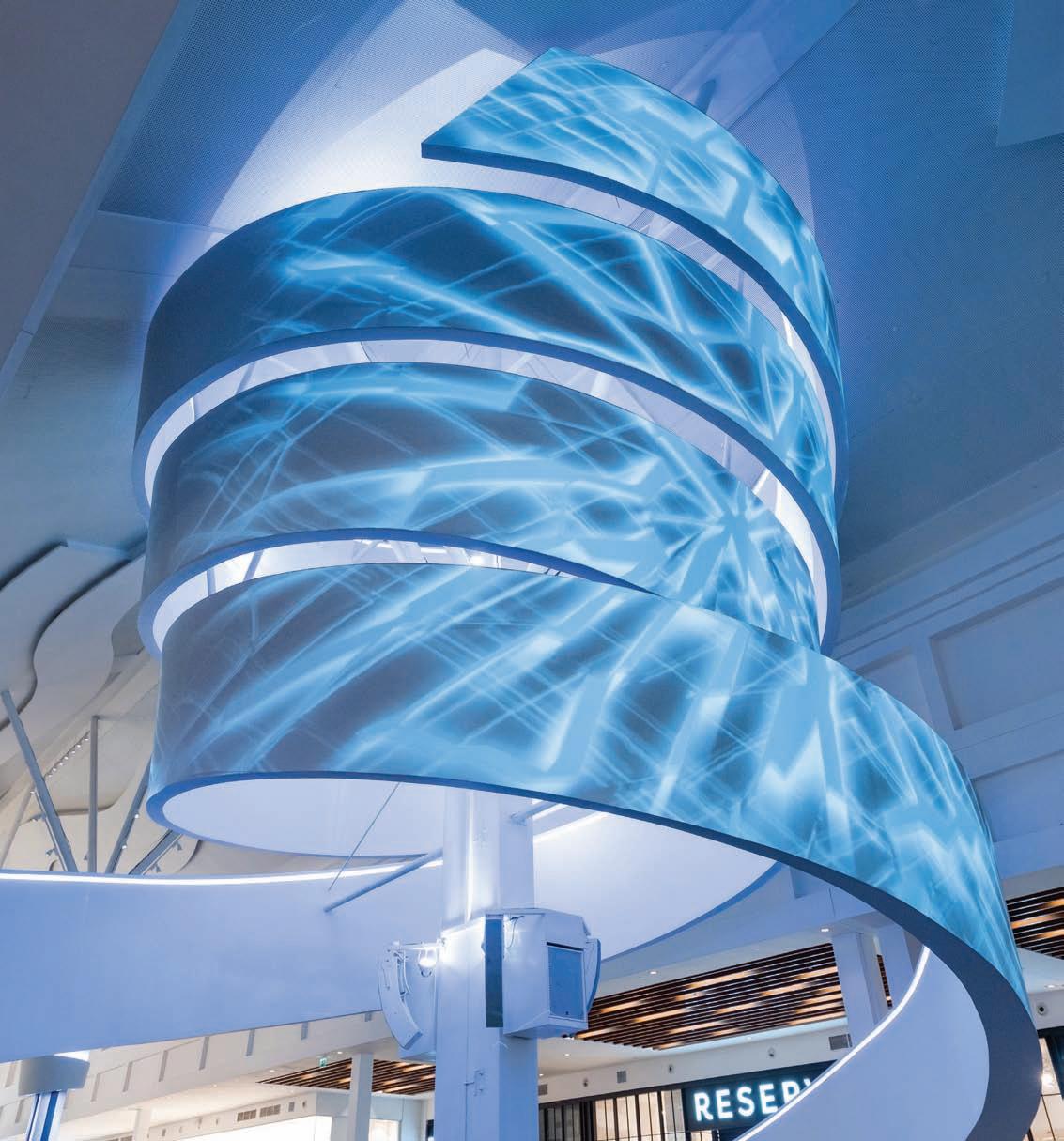
9 minute read
Zeleno Park Shopping Centre
VIRTUAL MEETS PHYSICAL
Inspired by the forces of nature, ACT Lighting Design's multidisciplinary team combined creativity and technology to create IMX-Immersive Experience - a three-dimensional structure inside Moscow's Zeleno Park shopping and leisure centre, decorated with multimedia content, visual scenography and multiple lighting features.
Advertisement
Armed with its expertise in the retail industry, ACT Lighting Design took upon a new challenge at Moscow's Zeleno Park shopping and leisure centre - to design, develop and produce an immersive multimedia installation inside. Following the client DG19’s requirements for visitor experience, branding, differentiation and strong visual identity, ACTLD's multidisciplinary team elaborated a turnkey creative and technological solution: IMX, a fourteen-metre high and 19.3-metre wide multimedia sculpture created to become Zeleno Park’s distinctive signature. The concept focuses on a multi-sensory approach that encourages the visitors to explore the structure’s interface and enhances the spatial experience through visual, interactive and dynamic elements. By merging the virtual with the physical, ACTLD wanted to explore all potential and seize the opportunity of IMX to stimulate the connection between the users and the commercial space by integrating
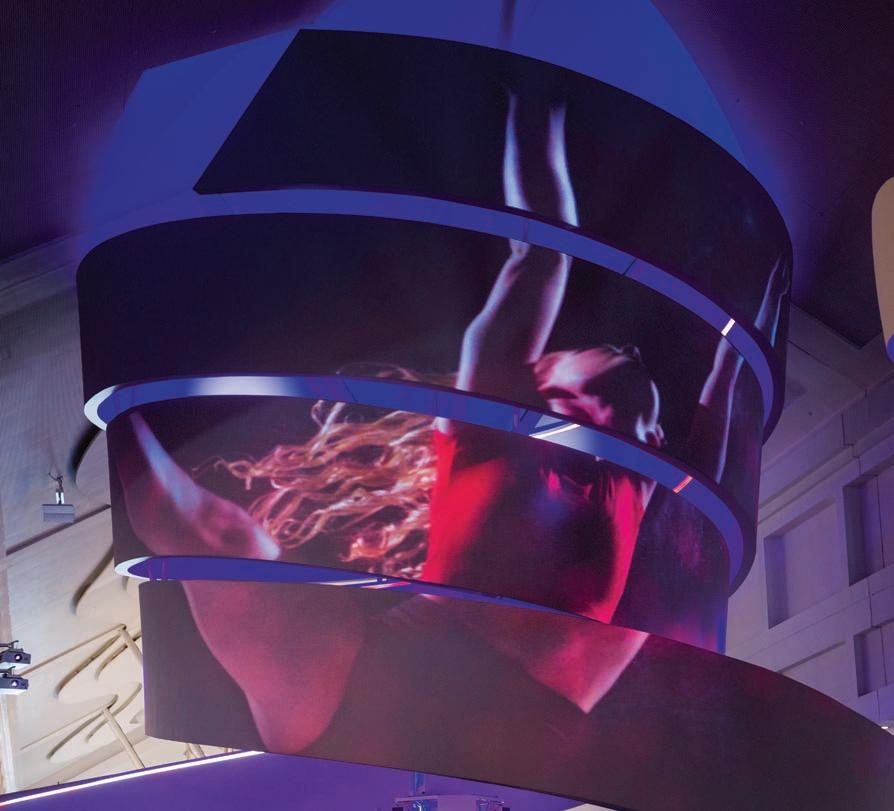
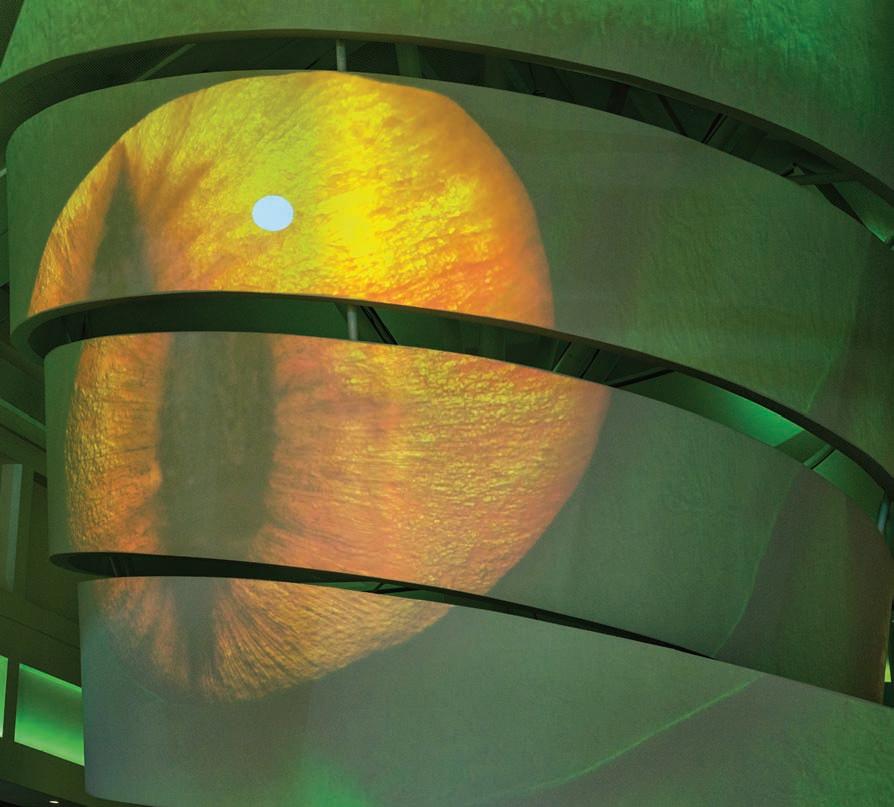
the visual scenography, multimedia content (video animations, projections and lights) and an original music score with sound effects, were inspired by the nature and form of the sculpture itself, which is equipped with multiple lighting features and madeto-measure lighting fixtures that ensure the visual coherence within Zeleno Park
storytelling, interactivity, original shows and branding in a playful way that awakes all senses. The team had to work within the existing architecture and implement the IMX structure without interfering with the building, keeping a five-metre distance from surrounding shops and allowing the flow of visitors under it. The structure, in the form of a vortex, is composed of two-mirrored halves of a spiral that follow and embrace one another, fully occupying the space in depth, width and length to offer a visual experience from a 360° point of view. The three-dimensional structure, inspired by the whirlpool, embodies a powerful dynamic energy. The visual scenography, multimedia content (video animations, projections and lights) and an original music score with sound effects, were also inspired by the nature and form of the sculpture itself. A multimedia show is played on the structure and its surroundings every hour. Various interactive games and brand boxes with digital commercial content are proposed to the customers in between the shows. With an unsurpassed breadth and depth of functionality, the sculpture and its surroundings were equipped with multiple lighting features and made-to-measure lighting fixtures that ensure the visual coherence within Zeleno Park. The inner side of the sculpture includes eight LED projectors and 160 lineair meter of pixel controlled led lines. Eight projectors cover the surface of 210m² on the exterior of the sculpture. In total 1540 linear meter of RGB led lines was integrated in the ceiling and surrounding wall coves, two Central audio systems inside the sculpture and four sound showers as well as eight touch screens were implemented to provide a complete system that offers an extensive range of future creative and technical possibilities. www.actlightingdesign.com
Pic: Light Attendance GMBH
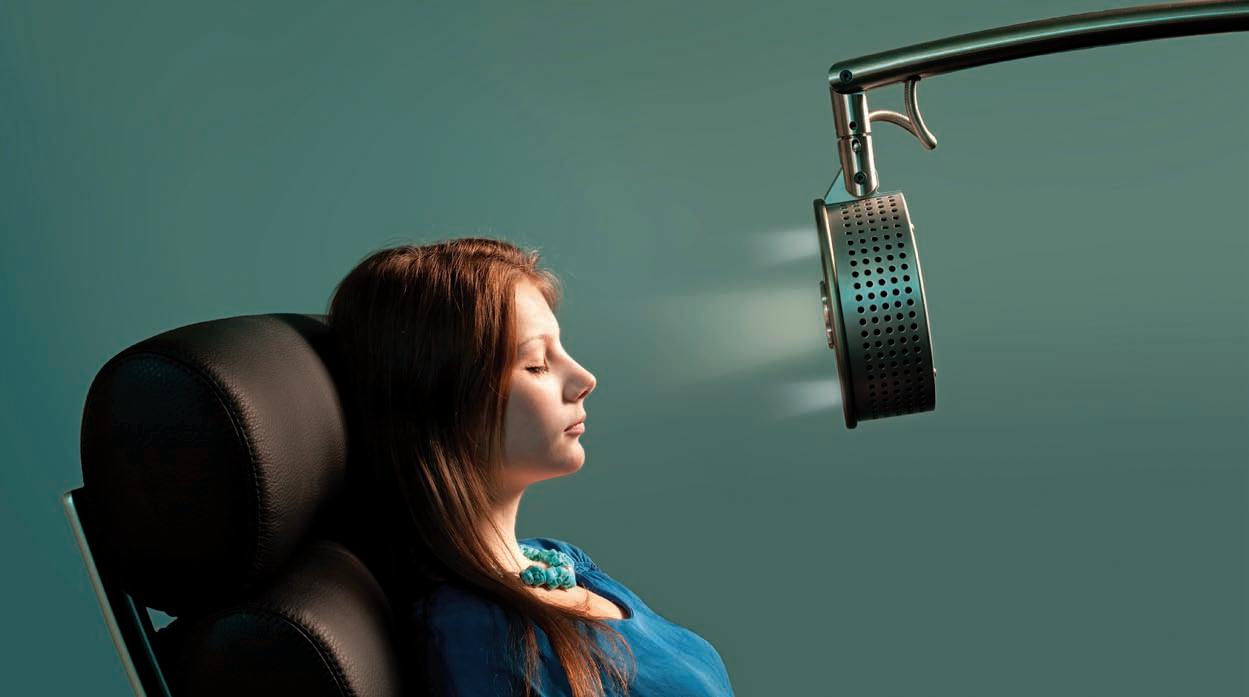
UP CLOSE AND PERSONAL
1000 petals, a new alternative healing sanctuary in Bengaluru, powers the Austrian Lucia No.03 light machine towards deep relaxation and blissful experience, discovers Ragini Bhow.
Taking seat in a comfortable chair, I lean back and shut my eyes. A warm light beams on my face, slowly increasing in brightness, flooding through closed eyelids. To my amazement, in minutes I find myself traversing another world, fractal light tunnels flying at rapid speeds, foreign planets’ horizons that come and go in flashes, radiating geometric masks and dancing glowing orbs. Ever so often the light vanishes, leaving me in solitude of darkness woven with ephemeral light residues appearing and disappearing like spirits from my vision. After flying through this maze of wonder for what feels like hours, my urge to feel the ground overwhelms me; crawling off the chair, I lie on the floor, finding balance once again as my heart beats steadily against the ground. I gently open my eyes to allow the room’s natural light in, as I find my footing in this reality again. It has been sixty minutes, and I have just completed a session with the Lucia No.3 light. We are very much aware of the significance light embodies in daily life, perhaps to a point where the relationship between light and the body can be taken for granted. Some speculate that matter may very well be the amalgamation of fragments of light energy where the body performs merely as a transmitter and receiver of these energies. As walking breathing light beings, our health is intimately linked with light as a substance essential for biological processes, such as circadian rhythm and sleep regulation. Ancient cultures, including the Mayans and Egyptians, long before discovered the metaphysical significance of light and engaged with the substance as a medium for healing, a gateway to altered states of consciousness, and as a tool used during divination. The contemporary brings new cutting edge light technology that opens doors for one to actively engage with light energy in a therapeutic context. After a transformative near-death-experience, Austrian neurologist Engelbert Winkle created the instrument Lucia No.03, a hypnagogic light machine inspired to simulate commonly observed light phenomena during near-deathexperiences. The machine is designed to bring about mental relaxation and elevated experiences with consciousness through constant stimulation of the pineal gland, a crystalline structure within our brain, that functions as a light receptor. The Lucia is minimally composed of one low voltage central halogen lanp along with 8 LED lamps placed in a circular fashion. The bulbs strobe in programmable rhythmic patterns when placed directly in front of the user’s closed eyelids. The constant light stimulates temporary EEG brainwave patterns that help users enter a hypnagogic trance. 1000 Petals Bengaluru powers the first Lucia light experience in South East Asia. It utilizes a three-step process during the session. Beginning, the facilitator curates a session according to an appropriate duration, frequency sequence and intensity based on the user’s preferences. The user then travels through the session as the light is turned on, accompanied with ambient sounds played to tune out noise. Upon completion, the facilitator opens opportunity for discussion surrounding the journey experienced. Testimonials from various users reveal positive reactions towards the light. A few of the many reported benefits include deep emotional happiness, reduced anxiety, and increased awareness detached from body. One user, a professional musician, expressed curiosity in the uniqueness of the visual quality during the therapy session. He found fascination in the complex patterns seen, inspite of the eyes being closed. This suggests that it may very well be the inner consciousness surfacing, reacting and formulating imagery from something as astonishingly simple as a flashing light. Another testimonial from a social hydrologist reveals the importance of the periods of darkness during the session, as contrasting moments of subtle beauty that inspire the mind to reflect and find peace. By utilizing scientific technology as a means to experience the spiritual, the Lucia light opens doors towards new ways of seeing and perceiving light, creating periods of contemplation and bliss within the chaos of the city. www.1000petals.in www.gesund-im-licht.at
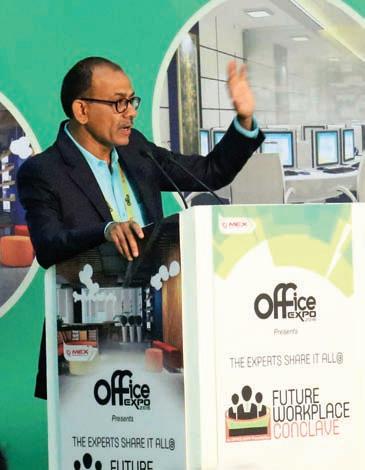
praveen rawal sonali Bhagwati, vipin chautani, akash kakar and amit gupta
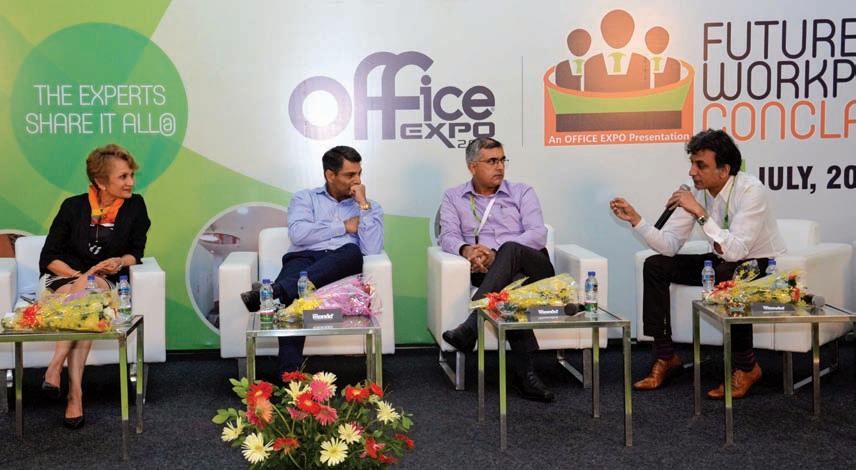
being OFFiCiAL AbOUT iT
Office Expo 2016 hosted the Future Workplace Conclave on 31st July in New Delhi. mondo*arc india played a critical role in supporting the conference as a primary media partner.
Office Expo 2016, the flagship show for the office sector was held in New Delhi between 29th and 31st July. Looking beyond a furniture and interior showcase, it offered dedicated sectors for the best technology to give efficient workplaces. mondo*arc india was proud to be associated as a Media Partner, and also participated in the affiliated event, Future Workplace Conclave. The first of its kind, Future Workplace Conclave for the office industry aimed to drive knowledge in key areas of office design, automation and management services towards building efficient and modern workplaces to improve overall aesthetics and productivity. The conclave provided an opportunity to develop strategy and plans, discuss issues, and engage with stakeholders. The agenda included focused presentations from an expert panel of corporate professionals on a variety of interesting topics such as office automation, office furniture, office interior and design, office technology, office management services, office supplies, office lighting and office spaces. One of the most critical discussions was centered on ‘Ergonomic Lighting for Futuristic Offices’. Moderated by Praveen Rawal (Managing Director, Steelcase), the panelists included architects Sonali Bhagwati (President, Designplus Associates) and Vipin Chautani (CEO and MD, Synergy Corporate Interiors Pvt. Ltd.), and lighting professionals Akash Kakar (MD, LSI) and Amit Gupta (Director, vis a vis and Publisher, mondo*arc india). With reference to the future of workplace environments Sonali Bhagwati discussed the current trend of merging boundaries between hotels, homes and offices – creating areas of wellbeing and comfort that perhaps negate the conventional formality of office decorum. She referred to the loss of a definitive outline of ‘office time’ as opposed to ‘home time’, wherein people today are working round the clock. Vipin Chautani elaborated on the palette of presence, posture and place, and how these factors define a workplace. Adding to the environment-centric conversation, Akash Kakar emphasised on the critical role that lighting plays in the office space. He extrapolated on fatigue levels experienced by workers under varying light conditions, touching upon the phenomenon of dynamic lighting solutions. Biodynamic light is gaining popularity across the globe as a revolutionizing prospect – light conditions in the interior space change through the course of the day with respect to the changing quality of daylight outside, reflecting on a natural cycle of response, which corresponds to the human circadian system. Amit Gupta was quick to highlight that, “People ignore design that ignores people.” And thus, there is an intrinsic need for the design of a workplace environment to respond to people, their needs and factors that would ensure comfortable and efficient working conditions. This could translate into providing huddle spaces that increase collaboration, break out spaces that encourage engagement, and flexibility of time and space, extended beyond the standard. The panel discussion was followed with an interesting presentation by lighting designer Jaspreet Chandhok (Partner, Ethereal Designs), establishing lighting as an important aspect of ergonomics and good health. “Our biorhythm works in tune with the level of lighting, and improper lighting can cause general fatigue, high rates of errors, low productivity and lack of concentration.” Listing solutions for common predicaments, she suggested opting for indirect and medium intensity lighting, appropriate colour temperatures and synchronizing lighting according to daylight. The first Future Workplace Conclave successfully concluded with an overwhelming response, opening the floor to innovative thought, and paving the way for future debate that could lead to potential developments in the sector. www.theofficeexpo.com
